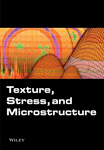Hot-Extruded and Cold-Rolled Textures of the Matrix Aluminum in Deformation Processed Two-Phase Nb/Al Metal-Metal Composites
Abstract
In this article, the powder metallurgy technique combined with flat hot-extrusion and cold rolling processes was employed to fabricate 10 and 20vol.%Nb/Al metal–metal composite sheets. The hot-extruded and coldrolled textures of the matrix aluminum in these metal–metal composite sheets were investigated by three dimensional orientation distribution functions (ODFs) analysis. The results show that the extrusion mode and large second phase particulate metal, Nb, have strong influence on the development of the extrusion and cold rolling textures in composites’ matrix. The matrix Al forms β-fiber textures after flat hot extrusion, where the components consist of B′-{011} ‹322›, S′-{124} ‹654› and C′-{113}h332i. After cold rolling process, only B′-{011} ‹322› changed to B-{011} ‹211› while the other components remained the same. The large particles in composites affect the matrix deformation in such a way that separates the distorted or bound zones from the deformation zones, which resulted in the final cold rolling deformation textures.




